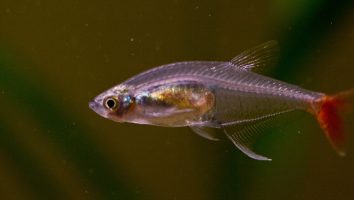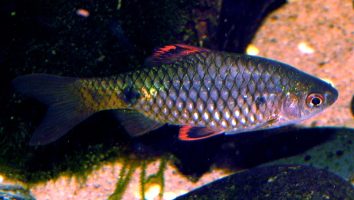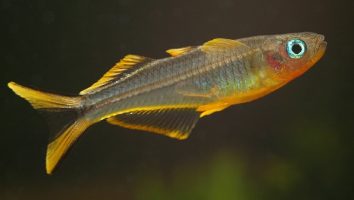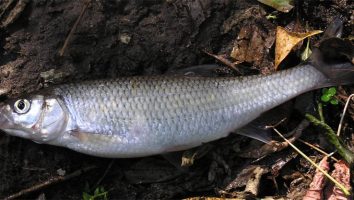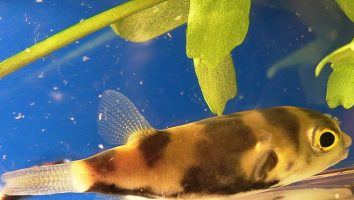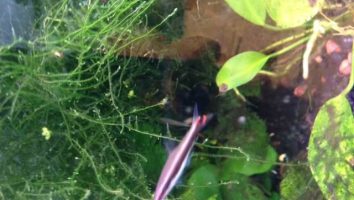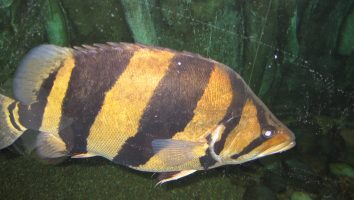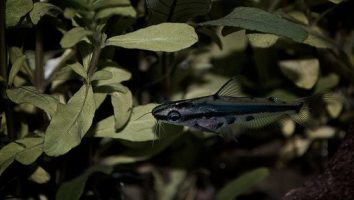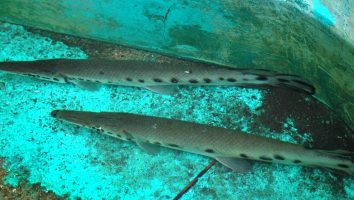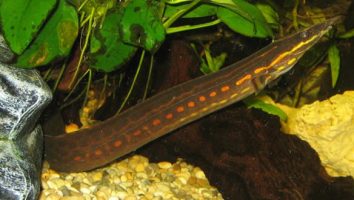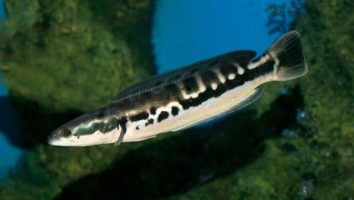The angelfish is a freshwater fish that is popular among beginner and experienced aquarium keepers alike.
This is because they’re relatively easy to care for, and they come in a wide variety of colors and patterns.
Angelfish are also a peaceful fish, which makes them a good choice for community tanks.
But even though they’re not difficult to care for, there are still a few things you need to know before you get one.
In this guide, we’ll teach you everything you need to know about angelfish care. Tank size, diet, tank mates, and more.
Table of contents
Species overview
Angelfish (Pterophyllum scalare) are a freshwater fish that are native to the Amazonian rainforest.
They are a popular choice for aquariums because of their unique shape and beautiful patterns.
Angelfish are generally peaceful fish, but they can be territorial with other angelfish and fish of similar size and shape.
The biggest threat to wild angelfish populations is habitat destruction, but they are also popularly collected for the aquarium trade.
Appearance
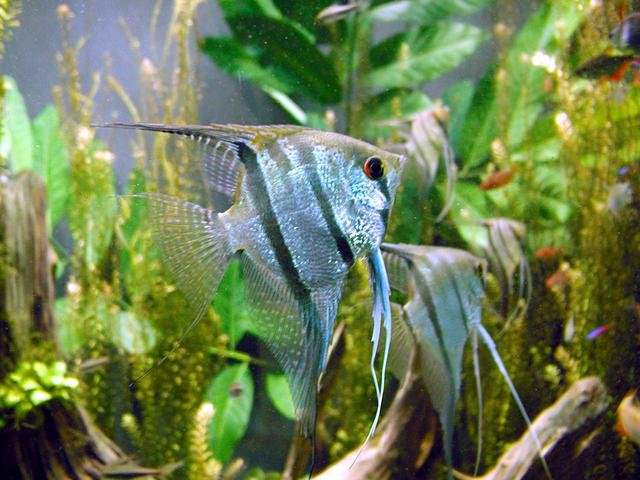
Angelfish are a fresh and saltwater fish that are very popular in the aquarium trade. They’re very distinctive looking fish that are easy to spot in a store or online.
The body shape of an angelfish is very tall and thin. They have a long dorsal fin that starts about two-thirds of the way back on their body and extends all the way to the end of their tail.
This dorsal fin has a very unique shape that resembles a sail when viewed from the side. The anal fin is much shorter and starts closer to the middle of the body.
The caudal fin is forked and symmetrical. The pectoral fins are long and thin. The ventral fins are very short and located close to the anal fin.
One of the most distinctive features of the angelfish is their long and slender mouth. This mouth has a downward curve and is filled with long thin teeth.
The eyes of the angelfish are located on the top of their head. They have a very unique pattern on their body that is made up of vertical stripes.
The coloring of these fish can vary quite a bit. They can be anything from a pale white to a deep black. The stripes on their body can be any color as well.
Lifespan
The average lifespan of an angelfish is around 10 years. There are however a number of factors that impact their life expectancy.
For starters. if these fish haven’t reproduced then their lifespan will usually be on the higher side of this range. That process can really take a toll on the fish.
The general level of care they receive obviously matters a great deal as well. Even though these are very hardy fish, they’ll obviously live longer in optimal conditions.
Size
Angelfish are a bit larger than Cherry Barbs, with a maximum size of about 4 inches. They are also a bit slower-growing, so it may take them a bit longer to reach their full size.
Tank
Tank Size
The minimum tank size for angelfish is 20 gallons. If you want to keep more than one angelfish in the same tank, you need to add at least 5 gallons of extra space for each additional fish.
We recommend a tank size of at least 30 gallons if you want to keep a pair of angelfish. If you want to keep a school of angelfish, you will need an even larger tank.
Water Parameters
Angelfish come from the Amazon river basin in South America. This is a tropical region, so the water is warm and the pH is slightly acidic.
In the wild, angelfish inhabit slow-moving waters with plenty of vegetation. There’s not a lot of movement to create turbulence and oxygenation comes from the plants.
You can replicate these water conditions in the home aquarium by maintaining a consistent water temperature and using live plants to help with oxygenation and filtration.
- Water Temperature: 75 to 82 degrees Fahrenheit
- pH Levels: 6.0 to 7.8
- Water Hardness: 2 to 12 dGH
- Alkalinity Levels: 4-8 dKH
What To Put In Their Tank
Angelfish are one of the most popular freshwater fish for a home aquarium. They’re relatively easy to care for and have a ton of personality.
One of the best things you can do when setting up an aquarium for angelfish is to give them plenty of places to hide. These fish are naturally shy and will appreciate some caves or plants to hide in when they feel threatened.
Another thing to consider is the substrate. Angelfish come from South America and typically inhabit slow-moving rivers. As a result, a sandy substrate is going to be the best choice for them.
This will allow them to easily sift through the sand and find any food that’s been buried. It’s also a lot more comfortable for them to swim in since it’s softer on their fins.
When it comes to plants, you have a few different options. Angelfish are known to nibble on vegetation, but there are some plants that are more resistant to this than others.
Some good choices include Java Fern, Anubias, and Hornwort. These will add some much-needed greenery to the inside of the tank and provide your fish with a place to hide.
Common Diseases
Angelfish are a very popular freshwater fish, and they’re also quite hardy. That being said, they can still get sick from time to time.
The most common disease that affects these fish is ich. This is a very contagious disease that is caused by a parasite.
The most obvious symptom of ich is the presence of white spots on the body, fins, and gills of your fish. If you notice this, it’s important to take action immediately.
The good news is that ich is fairly easy to treat, and most fish will make a full recovery if you catch it early enough.
Another disease that can affect angelfish is problems with their swim bladder. This is a condition that can be caused by a variety of things, but the most common cause is constipation.
The most obvious symptom of this is when your fish has trouble swimming properly. They may swim sideways or upside down, and they may have trouble staying afloat.
If you notice this, the first thing you should do is check the quality of the water in their tank. If the water is dirty, that could be the problem.
You should also check to see if they’re eating properly. A lack of food can also cause constipation.
If you’re not sure what the problem is, it’s always best to consult a vet. They will be able to help you figure out what’s wrong and how to treat it.
Behavior & Temperament
Angelfish are a bit more difficult to keep than other freshwater fish because they are semi-aggressive. They are known to be nippy, and they may even attack other fish in the tank if they feel threatened.
It’s best to keep Angelfish in a tank by themselves, or with other fish that are too large to be considered prey. If you must keep them with other fish, make sure to provide plenty of hiding places so the smaller fish can escape if necessary.
Angefish are also known to be fin nippers, so it’s not a good idea to keep them with fish that have long fins. They may also bully other fish in the tank by chasing them and nipping at their tails.
Overall, Angelfish are beautiful fish to look at, but they can be a bit difficult to keep. If you’re up for the challenge, they make a great addition to any freshwater tank.
Tank Mates
Angelfish are one of the most popular freshwater fish for aquariums. They’re beautiful, unique, and come in a variety of colors and patterns.
But before you run out and buy one, it’s important to know that they’re not the easiest fish to care for. They’re also not the best community fish.
This is because they’re semi-aggressive, and their long fins make them a target for fin-nipping fish.
As a result, you need to be careful when choosing tank mates for angelfish.
Here are some compatible species that tend to work well:
- Dwarf Gourami
- Pearl Gourami
- Honey Gourami
- Black Widow Tetra
- Bloodfin Tetra
- Congo Tetra
- Cardinal Tetra
- Serpae Tetra
- Rummy Nose Tetra
- Flame Tetra
Breeding
Angelfish are one of the most popular freshwater aquarium fish for a reason: they’re absolutely beautiful. But did you know that they’re also pretty easy to breed in captivity?
The first step is to set up a breeding tank. It should hold at least 20 gallons of water and be equipped with a sponge filter. Then, add some live plants and driftwood for hiding places and to help with water quality.
You’ll also need to create a spawning mop. This is just a piece of yarn that the female can lay her eggs on.
When ready, add two males and one female to the tank. The female will be the largest of the three.
Give them time to acclimate and get comfortable in their new home. Then, start feeding them live foods. This will help to trigger spawning.
Within a few weeks, you should see the female start to lay eggs. She’ll lay them on the plants or on the spawning mop. The male will then fertilize them.
Once the eggs have been laid, remove the adults from the tank. The eggs will hatch in about a week.
Once they hatch, the fry will feed on the algae in the tank. You can supplement their diet with live foods or finely crushed flake food.
As they grow, you can slowly start adding them to your main tank. Just be sure to do it gradually so you don’t shock the system!
Conclusion
Angelfish are one of our all-time favorite freshwater fish. They’re absolutely stunning to look at and relatively easy to care for once you understand their needs.
If you’re thinking about adding an angelfish to your tank, we say go for it! We think you’ll be very happy with your decision.
Just be sure to do your research beforehand and be prepared to meet their needs. With a little bit of care, your angelfish will thrive and be a beautiful addition to your tank.

